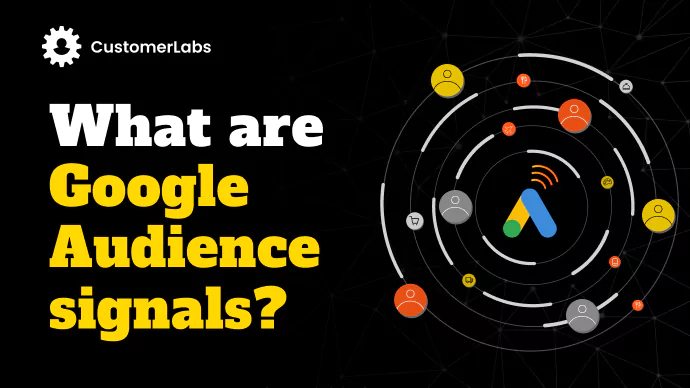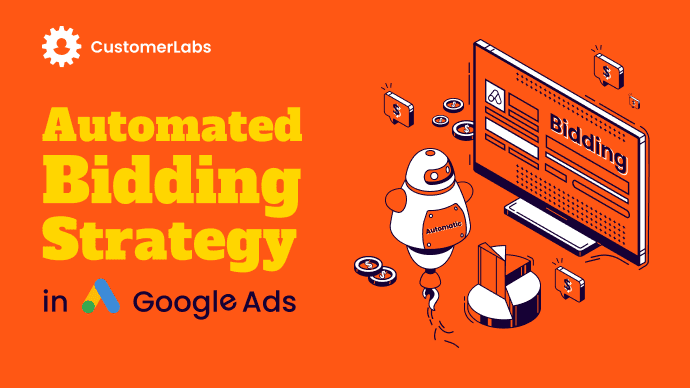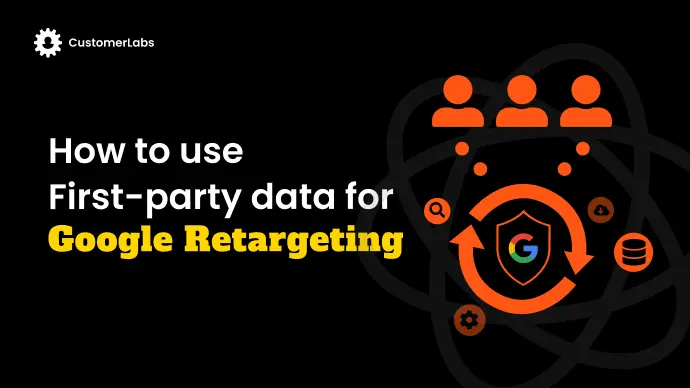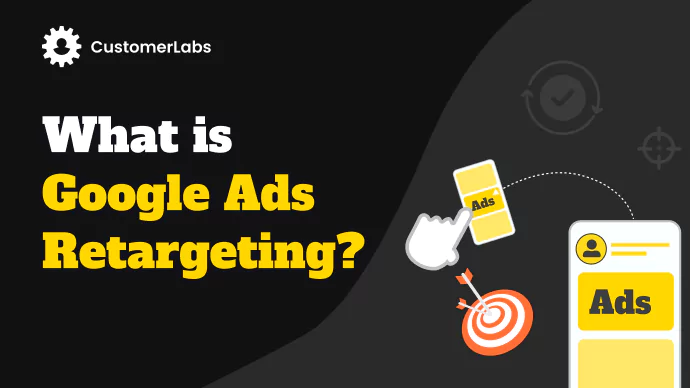
In the era where acquiring new customers through top of the funnel campaigns through digital marketing is difficult, Google retargeting comes as a ray of hope. The most underused or underrated feature of Google Ads is Google retargeting. It helps you reach high-intent users who have shown considerable interest in your product/service.
Enhance your marketing efforts by adopting the advanced Google retargeting strategies to contribute to your branding efforts and to finally boost your profits!
To understand how Google Retargeting works and to make the maximum use of Google Retargeting dive in to read.
What is Google Retargeting?
Google retargeting is a feature offered by Google Ads that helps you show ads to people who have previously interacted with your website/app/social media/ads. Using Google Ads you can engage with people who are already aware of your brand or have shown a certain level of interest in your brand/product.
Google retargeting is a strategy that works to
- Convert your website / app visitors into customers, and
- Increase the lifetime value of your existing customers.
It also aims to help those users who are stuck in the ever-perplexing loop of mid-funnel to come out.
Is Retargeting and Remarketing the same?
In the context of Google Ads, both retargeting and remarketing can be used interchangeably.
However, the prime difference between retargeting and remarketing is – retargeting is for unknown users and remarketing is for known users.
If you are targeting website visitors or users whose known details like email address & phone number are not available, it is called retargeting.
If you are targeting the users through email, calls, or any other medium based on the data you possess, where you have the identifiable information of the user it is called remarketing.
Consent Mode v2 Mandatory To Run Google Retargeting Ads
Starting March 6, 2024, it is mandatory for all advertisers in the EEA (European Economic Area) including the UK (United Kingdom), to implement Google consent mode v2. The Google consent mode v2 brings two new parameters ad_user_data and ad_personalization. The latter parameter receives users’ consent for Google retargeting ads.
If you do not setup consent mode v2, Google Ads will fail to target the users in the EEA. Not just that, your conversion data also takes a hit, resulting in data discrepancy and attribution. Even if you do not run ads, but have the traffic flowing through the EEA, consent mode v2 is mandatory.
Start implementing consent mode even if you are not concerned with the EEA, to be prepared and stay ahead! Talk to our experts to setup Google consent mode v2.
How does Google Retargeting work?
Google retargeting works by collecting your app or website visitor data using a pixel and then using that data on Google Ads to find that same audience to show them the ad.
Note: Pixel here is nothing but a snippet of code that collects and tracks the app or website visitor data as they browse.
Below is the infographic showing how Google Retargeting Works:
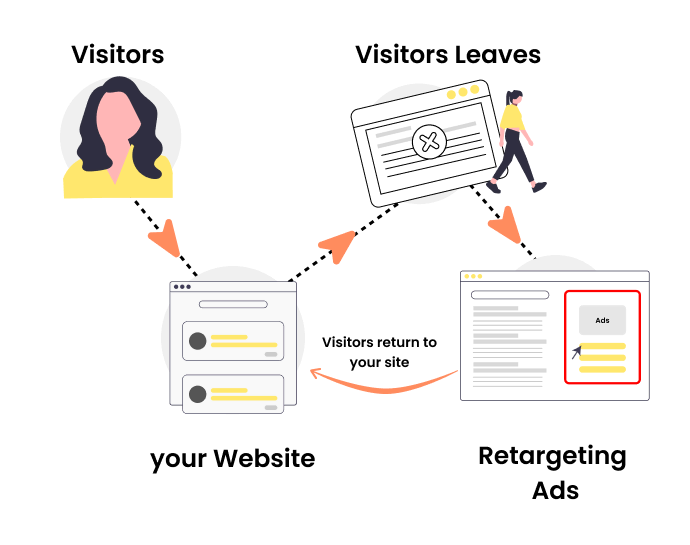
Let us understand this with an example:
Step 1: Visitor landing on the website
Let us take an eCommerce store selling men’s fashion. Upon examining the user journey, we found that
- A particular website visitor has landed on the home page
- He/she viewed the red shirt and clicked on it
- Then browsed different other products
- Again visited the same red shirt
- In total, he/she visited the red shirt 3 times
- Added the red shirt to the cart
- The visitor exited the website
Step 2: Pixel capturing the user journey
While the visitor was browsing through the website, the pixel will have all the data collected by using the browser-side cookies. The data that browser-side cookies will collect include:
- Interests and online shopping trends
- Language preferences
- Location
- Previous browsing activity
- Time spent on the website
- Visited subdomains
- And other parameters
Step 3: Syncing the user behavior data to Google Ads
After collecting all the above data it will be sent to Google Ads if you have setup the Google Ads pixel on your website.
Tip: Send the audience lead data along with value to leverage value based bidding in Google Ads.
Step 4: Retargeting the user with Google Ads
Google Ads will now retarget the visitor using the data the pixel has collected.
It will show the ad creative you wanted to show. In this case, you can show the user who viewed the red shirt thrice, an ad consisting of a red-shirt with a or $10 OFF 20% discount offer ad creative.
Thus, the probability of the visitor making the purchase will be higher.
Here’s the catch
In general, the above used to happen in the good old days before iOS14 by using browser-side cookies.
Now, Google is unable to collect and retarget all the website visitors on Google Ads because of the third-party cookies being blocked on major web browsers.
Therefore you have to setup server-side tracking to collect your website visitor data and sync it with Google Ads effectively.
Six Different Types of Google Retargeting Campaigns
The different types of Google retargeting Ad campaigns are:
- Search Retargeting campaigns
- Display Retargeting campaigns
- Video Retargeting campaigns
- App Retargeting campaigns
Apart from the ad campaign types, primarily, Google has two different types of Retargeting strategies that can be used in the above strategies:
- Standard Retargeting Campaigns
- Dynamic Retargeting Campaigns
Therefore, in total, there are six different types of Google Retargeting. Let’s take a look at what they are and how they are used in detail. After that let us understand standard retargeting campaigns and dynamic retargeting campaigns.
Search Retargeting ad campaigns
Search Retargeting ad campaigns, also known as Retargeting Lists for Search Ads (RLSA) are those retargeting campaigns that retarget the users on the search engine.
Retargeting List or the remarketing list (now called ‘your data’) is the data of your audience that you sync with Google Ads. These audiences mostly consist of all your website visitors and are already familiar with your brand/product.
For small businesses, Google Ads seems to be pretty expensive. To make use of Google Ads in a cost efficient way, small and medium businesses can opt for RLSA.
When you setup an RLSA campaign, you equip Google Ads with a list of keywords, your data, targeting, location, other audience signals and a set of negative keywords. Now Google Ads will target and show your ads to the audience in your data when that person in the list of your data searches on Google.
How does RLSA work?
To understand how RLSA campaigns work, see the below image:
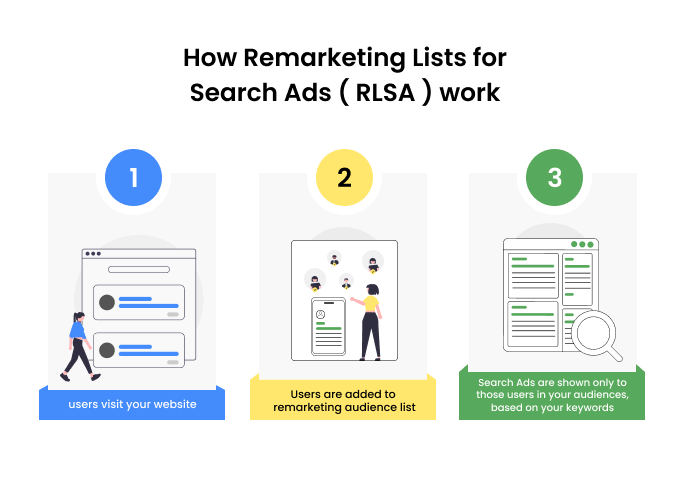
Let’s assume that person C visits your website.
Based on C’s journey you segment and add to the remarketing audience list. That is, you collect your first-party data.
Now when C goes on to Google Search and searches for something related to your keywords, Google Ads will show them your ad.
Therefore, your RLSA campaigns show search ads to the users only in your audiences list and based on the keywords you provide in the ad campaign to the ad algorithm.
When a person is searching for something it means that the person is highly interested in that particular product or service.
Capturing their attention at that point in time makes it easier for you to make them purchase your product or service.
Therefore, RLSA proves to be cost effective and beneficial to businesses to make the most out of Google Retargeting Ads.
Pro tip:
Using intent-based searches (transactional searches and commercial searches) might fetch you better conversions compared to navigational and informational searches.
Example of how RLSA works:
Let us assume you are running a digital marketing firm. A user visited your website and has checked your web page.
You have collected that user’s journey and all the user behavior data. Next you sent this data to Google Ads using the audience manager.
Next, choose Search Ads campaign, select relevant options and continue to audience segments. Here choose your data segment. Choosing your data segment will make your ad campaign RLSA.
At the ad group level, you have to choose either phrase match or exact match. If going with a broad match, you can choose it for the entire campaign.
Next you will have to upload a keywords list. Let’s assume that one of your keywords is ‘best digital marketing agency in New York’.
Now after some time, the user searches on Google search engine for the ‘best digital marketing agency in New York’.
That user who visited your website will see your. That user clicking your ad to get converted into a Client is just a matter of time.
Therefore, this is how you spend less money as the user who clicks will have a high probability of converting. Therefore, increasing your CTR and conversion rate. This will optimize your ad spend.
Tip:
You can also exclude a certain segment of your audience for a few keywords. You can also add a list of negative keywords to the ad campaign.
For example, there is no use in showing your ad to someone who is already converted. It is also irrelevant to show the ad for a keyword which you feel the user might not purchase.
Thus micro-segment your audience, and include negative keywords to optimize your ad spend on Google Ads.

Display Retargeting Ad campaigns
Google Display Network (GDN) consists of millions of websites where your display ad campaigns will be shown. When you go with the ‘your data’ audience, you can retarget those audiences across the internet with personalization.
In RLSA, the ads are shown only when the user searches for the product. Whereas in the display retargeting ad campaign, the ad is shown even before the user searches for the product. It works based on the user behavior on your website.
How Display retargeting Ad campaigns work?
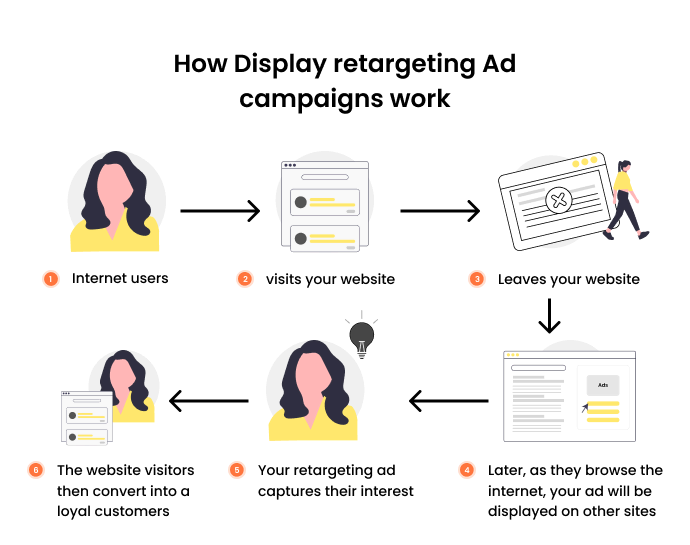
Display retargeting ad campaigns personalize the experience of your audience across the internet by showing your ads at the interval and frequency you set.
For example, let’s assume that a user has visited your website and just left without making any purchase. Now, you can show your ads to that user across the web.
While setting up a display ads campaign on Google Ads, use ‘your data’ segment to go with the retargeting feature.
When you do this, Google Ads will display your ads to the audience in your data across the Google’s Display Network.
When the user is browsing through the Google display network, your ad pops up for the user. As it is very much relevant to the user, the probability of the user clicking the ad is high.
Example of Display retargeting Ad campaigns work:
Let us assume you are an eCommerce Client. A user visited your website and has checked a particular red shirt on the website more than 3 times, browsed through other catalogs once, and did not make any purchase.
Once you collect that user’s journey and send this data to Google Ads to set up display ad campaigns, the ads keep appearing on Google Display Network.
Now after some time, the user visits some website out of the million websites on Google Display Network or maybe just opens Gmail. Now, the user is shown ads with a discount on the red shirt the user viewed.
That user clicking your ad to get converted into a Client is just a matter of time.
Therefore, this is how you optimize your ad spend by targeting users with a high probability of converting.
Pro-tip: When using display retargeting ad campaigns do not roll out generic ads. It will be more helpful if you run responsive display retargeting ads. For that, you need to add all your assets (ad creatives with high-quality images and customized collages), ad copies, headlines, descriptions, and logos. The AI of Google Ads will automatically show the combination of your assets to achieve the required goal of the campaign.
Video Retargeting Ad Campaigns
To capture the audience interested in visuals, Video ad campaigns are the best. With video ads, you have the custom option to choose the ad placement across YouTube and Display Network. The in-stream ads are also shown on video ad campaigns. Using ‘your data’ or the first-party data will help Google Ads retarget high-intent audiences.
In general, most marketers believe video ads are expensive. It is because the first five seconds of their video does not capture the audience’s attention. Therefore, the tendency of the audience to skip the ad is high. To avoid this, use retargeting video ad campaigns on Google Ads.
Google Retargeting using video ad campaigns will help you because
- The audience is familiar with your brand/product and has some sort of interest already.
- As you retarget with proper messaging very much inclined towards the high-intent audience, the probability of them skipping the ads is less.
- You can convey everything in detail through a video ad as compared to display or text ads.
- As you are giving as much information as possible, you are pushing the prospects out of the perplexed mid-funnel to make a decision and purchase.
Pro tip: A/B test your video ads regularly to monitor the performance of the ad campaign. Have two different audiences for each experiment. From the experiments identify which audience is offering better conversion rates. Choose the audience that is providing better results. Now run personalized & customized ads for that target audience.
Also, ensure that the first five seconds of the video ads have a hook and are engaging for the audience. Have a proper call-to-action at the end of the video.
You can also leverage dynamic retargeting to increase the personalization factor of your ads. With dynamic retargeting using video ad campaigns on Google Ads, you can run ads based on a particular segment.
For example, if you have an audience who visited the product display page and another set of audience who added to cart. Now you have two segments – product display page viewed and added to cart. You can run one video ad for product display page viewers and another video ad for cart abandoners.
Retargeting the cart abandoners alone using Google retargeting video ad campaigns has the high chance of converting them to customers. Therefore use Google Ads with retargeting video ad campaigns to convert cart abandoners into customers.
App Retargeting Ad campaigns
To retarget users who have interacted with your app or have used your app, you can go with app retargeting ad campaigns.
Why you should explore the Google Ads App retargeting ad campaign:
- Educate the users about the new features in the app
- Increase your app user’s lifetime value by retargeting them with in-app purchases.
- Show users ads on the apps they are using.
- Based on the user’s engagement on the App, retarget them with specific ads.
You can also collect the app user data, sync it with Google Ads and then retarget them with display ads or in-app ads, or any other ad campaigns across Google Ads.
Standard Google Retargeting Ads
Standard Google Retargeting ads are the general retargeting ads that allow you to interact with users who have already interacted with your website and/or app. Add those website visitors to your list called remarketing list or ‘your data’.
To run these standard Google retargeting ads, you would need to setup the Google Ads remarketing tag and to setup the remarketing tag, you need your conversion ID. The conversion ID is available at Tools > shared library > Audience manager > Audience sources > Google Ads tag card > Details > scroll to find Tag setup > scroll to find Google Ads tag section > scroll to select ‘use tag manager’ > copy the conversion ID

Once you have the conversion ID, go to Google Tag Manager and add New tag by selecting ‘New tag’.
Navigate to Tag Configuration > Google Ads Remarketing.
Here’s where you have to enter the Conversion ID. If you also have copied the conversion label, enter that ID as well.
Now comes the important step wherein you have to set up the triggers. Trigger is a way to setup which events you want to track. It tells when the tag should fire and for which event. For example, clicking on a button can be a trigger, scroll depth can be a trigger, or page view can be a trigger. To know more about types of triggers, read this official Tag Manager Help.
Pro-tip: To have better conversion measurement, set up a conversion linker.
Dynamic Google Retargeting Ads
While the standard Google retargeting ads retarget all the website/app visitors, Dynamic Google Retargeting Ads go a step further. These ad campaigns retarget the users based on their journey on your website/app.
For example, let us assume a user Y has visited your home page, then navigated to the category of products, then viewed a shirt and then left your website. Now standard retargeting with Google Ads will retarget that user for sure. But without much precision or customization.
Whereas, with dynamic Google retargeting, you can target the user with an ad that shows the product similar to what they viewed. Thus, you have more chance of tailoring your ad experience to the users.
As the user has already expressed a certain level of interest in that product, the probability of them getting converted into a customer will be higher if you are able to retarget them with tailored messages.
Therefore, dynamic retargeting goes a step further to tailor the ad experience to the users based on their journey / interaction with the product/brand.
To start your dynamic retargeting ad campaign on Google Ads, you have two options:
- Using Google Ads remarketing;
- Using Google Analytics remarketing
Confused which path you want to choose to setup your retargeting ad campaign? – Read Here and understand which suits you better.
Points to be remembered:
To use dynamic Google retargeting ads, you have to deploy the Google ads tag on every single page using dynamic values.
These dynamic values can be
- The details of the search terms that user searched on your website,
- Product ID of an item a user added to their cart,
- the coupon code of an offer a user had clicked on,
When you pass this dynamic value to Google Ads it helps retarget the audience who viewed that specific product/service/performed a certain action.
The data from the website can be pulled in various ways – first-party cookies, data layer, or a custom javascript. Assign the values to encash the dynamic retargeting. Check how to implement a retargeting tag to use it for dynamic retargeting.
Smart Dynamic Retargeting Ads
Moving a step ahead, you can retarget the audience based on customized events. For suppose, you might think to optimize your conversion rates or click-through rates for your ads.
So, instead of just using the regular dynamic retargeting ads, you can micro-segment your audience and then run the dynamic retargeting ads. This will be a smart move because, with micro-segmentation, you can retarget a wide range of audiences with personalized ads.
Some of the micro-segments you can use are:
- Product viewed more than 3 times, added to cart but not purchased
- Added to cart but not purchased in the past 28 days
- Product purchased with a higher order value
- Users with higher cart value
Using these advanced audience segments in dynamic Google Retargeting ads helps increase the click-through rate and conversion rates.

Setting up the Google retargeting ad campaign
To set up the retargeting ad campaign on Google Ads, you have to follow the below steps:
- Collect your retargeting audiences list,
- Choose the right targeting audiences
- Giving the right audience signals.
Collecting Your Retargeting Audiences List:
As a first step in setting up your retargeting campaign on Google Ads, install the Google Ads remarketing tag. After the tag is installed ensure that the tag is configured correctly.
Below is an example of a rightly configured tag vs a badly configured tag.
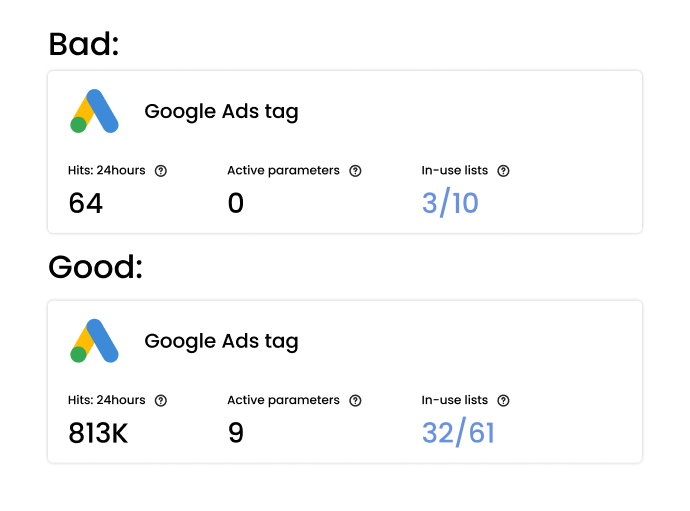
If you did not setup the tag yet, then go to Tools > shared library > Audience manager > Audience sources > Google Ads tag card > Details > scroll to find Tag setup
Once you set up the tag either using the Google Ads tag you should create the audience list.
Google’s algorithm is so complex that it does not just retarget your audience. It also tries to expand your audience net in real-time by having your data as the base. Therefore, giving quality data to Google Ads is very much important with automated bidding strategies.
Therefore it becomes important to use high-quality data by configuring Google Ads tag correctly.
Creating Retargeting Audience List:
After you segment and sync the data to Google Ads, you have to use this audience in your campaigns.
For that, click on campaigns, then the + symbol to create a new campaign.
Choose one campaign objective from the below on your Google Ads:
- Leads
- Sales
- Website Traffic
- Product & brand consideration
- Brand awareness & reach
- App Promotion
- A campaign without an objective
Select the campaign type and continue to give other parameters such as location, campaign name, etc.
Next comes the important step – choosing the audience.
Choosing the Right Targeted Audience:
Navigate to Audience Segment. Here’s where you have to choose the remarketing audience list by clicking on ‘your data segment’. Earlier ‘your data’ was called as ‘remarketing list’
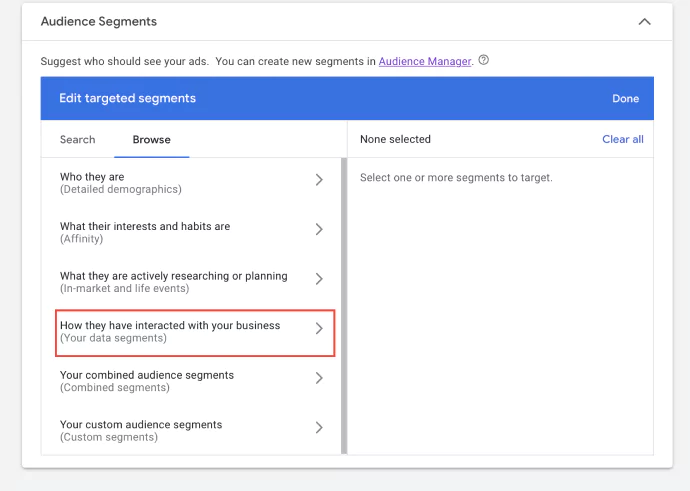
Once you choose this, you will have the option to include your website visitors based on how they have interacted with your website.
You can use multiple audience combinations to give complete information about who your target audience will be, to Google Ads algorithm.
Giving The Right Audience Signals:
The more data and the more signals you give, the better the algorithm works in targeting the right audience. To make use of retargeting strategy, you have to use only the website visitor data. Adding more audience signals will help the algorithm expand its audience net to target the expanded similar audiences with relevant ads.
Some of the audience signals you can give to filter out the high-potential customers are:
- Demographic details
- Interests and Habits
- In-market audiences and Life events
Using these, you can increase your ad personalization effectiveness. This will help you set up a retargeting campaign that gives better results.
Is this all you need?
Absolutely No. There is more than data to do in Google Ads retargeting campaign. One such thing is Ad Creatives.
Creating the right Ad Creatives for Retargeting campaigns on Google Ads
Ad Creatives & Ad Copy play a major role in making people click your ad in the first place.
For example, let us say US Polo is retargeting using Google Ads. They have segmented people who have viewed the UPSA V-neck red t-shirt more than 2 times in the last 7 days.
Now if they are running ads for that segment with a white round-neck t-shirt and ad copy that says “You viewed this a week ago. Get this to your Wardrobe Now!” This sort of retargeting will prove to be ineffective.
Instead, if they have run an ad that shows the same V-neck red t-shirt with the ad copy that says “You viewed this a week ago. Check out more collections and get it into your wardrobe now!”, it would work.
Ad Specifications for Google Retargeting Ads:
In addition to the above, you also have to keep in mind the ad formats and ad specifications for Google Ads. Below are the dimensions of images you should use for your Google retargeting ads
| Retargeting Display Ads |
| Ad Creative Type | Image size (Width px x Height px) |
|---|---|
| Banner Ads | 468 x 60 |
| Half Page Ads | 300 x 600 |
| Inline Rectangle Ads | 300 x 250 |
| Larger Leaderboard Ads | 970 x 90 |
| Large Mobile Banner Ads | 320 x 100 |
| Leaderboard Ads | 728 x 90 |
| Mobile Banner Ad Type 1 | 300 x 50 |
| Mobile Banner Ad Type 2 | 320 x 50 |
| Skyscraper Ads | 120 x 600 |
| Small Square Ads | 200 x 200 |
| Small Square Ad Type 2 | 250 x 250 |
| Square Ad | 300 x 300 |
| Retargeting Responsive Ads |
| Ad Creative Type | Image size (Width px x Height px) |
|---|---|
| Rectangle size responsive Ad Creative | 1200 x 628 |
| Square size responsive Ad Creative | 1200 x 1200 |
| Retargeting Discover Ads |
| Ad Creative Type | Image size (Width px x Height px) |
|---|---|
| Rectangle size discovery Ad Creative | 1200 x 628 |
| Square size discovery Ad Creative | 1200 x 1200 |
| Vertical size discovery Ad Creative | 960 x 1200 |
In addition to these, also go through the best practices guide for Google Ads by Google Ads.
Pro-tip: It is recommended to use high-quality images. Some experts recommend using GIF formats to capture the audience’s attention.
You Should Create Ads That Will Grab Attention:
Having the right ad creative sizes is not just enough. If you want a user to stop at your ad, you have to make it so catchy and grab their attention. Primarily, for video ads, the attention span is not more than 8 seconds as per certain reports and was reported across the media including some publications like the brief by Joseph McCormack.
That data is as per 2012 stats. Now with YouTube ads, you might have noticed that, if the video is not grabbing your attention in the first two or three seconds, you just wait for 5 seconds for that ‘skip’ option to be enabled to skip the ad. Only if the ad creative is grabbing your attention within those five seconds, you will view the ad and take a certain action as the ad specifies.
Pro tip: Never leave your ads without a proper call to action (CTA). You should give the options as to what the users can do and ease them to arrive at a decision.
How to run Google retargeting ads effectively:
- Give more first-party data as ad algorithms crave more and more high-quality data for it to learn more about the audience and use your data as a foundation for building similar audiences or lookalike audiences. The point to be noted is that similar audiences are no longer available in Google Ads. However, you have an option to either opt-in or opt-out for ‘Optimized targeting and audience expansion’. You can use this to toggle and play around with how you want your ad campaigns to run.
- Use the ‘exclude audience segments’ option. Using the exclusion well, you can increase the precision of targeting the right audience.
- Give a set of relevant ad copies when choosing the automated bidding on Google Ads. This helps the ad algorithm mix and match some of the options to check which is working and which is not.
- For the conversion to happen, your ad message should be reflected on the landing page. There should be very relevant and precise CTAs(Call-to-actions). This not only helps increase the Conversion rate but also builds brand trust, making the customer loyal to the brand. In the long run, this will also increase the customer’s lifetime value.
- For eCommerce, it is recommended to retarget the cart abandoners. This will push the cart abandoners back into the funnel and make a purchase.
- Retarget the users using Google Ads with complimentary products to cross-sell.
- Be specific with the messaging and transparent about the offerings in your ad creative with the users. This will help you increase your click-through rate (CTR).
How to measure the results of your retargeting campaigns:
There are many metrics you can use to measure the success of your Google retargeting ad campaigns. First and foremost is the amount of money spent on retargeting ads alone and how much revenue it fetches for your business in return.
However, that should not be the sole key performance indicator for your Google retargeting ad campaigns. Below are some of the metrics which you should track to measure the true success of your retargeting ads:
CTR (Click-through rate):
The number of users clicked on your ad out of the total number of users who viewed your ad. It is calculated by dividing the number of clicks by impressions and measured as a percentage.
CPM (Cost per thousand impressions):
M in CPM refers to the Latin word mille, which translates to thousand in English. It is calculated by dividing the total ad spend by thousand impressions (or a thousand times your ad was viewed).
CPC (Cost-per-click):
The cost incurred per single click on your ad. It is calculated by dividing the total ad spend by the number of clicks.
Conversion rate:
It gives you how many conversions have happened out of the total number of opportunities received from clicking your ad. It is measured as a percentage of your total leads or clicks. (lead to conversion rate or click to conversion rate)
CAC (Customer acquisition cost):
The cost incurred in acquiring a customer is calculated by dividing the total amount spent on your marketing campaign by the amount spent on it.
ROAS (Return on ad spend):
It can be understood as the total return on advertising spend. For suppose you spent $100 on a retargeting ad campaign and received let’s say $700 in return. That means you have a ROAS of 700% or 7X
POAS (Profit on ad spend):
Having ROAS as an indicator is old school and will drive your business nowhere. It is high time that you shift towards measuring your POAS. It is nothing but the total profit you have made on your advertising campaign.
By considering these metrics, you again have to revisit the optimization phase to make the Google retargeting ads work for you.
Case Studies & Use Case Scenarios:
How Campmor used Google retargeting ads to automate ad personalization:
Campmor is a retailer that has been selling recreational equipment since 1978. They launched their eCommerce store in 1998. From then to now, it has been a long journey of experimentation and succeeding & failing since then. Currently, along with other ad campaigns, they are running their ads across Google Display Network using dynamic and static retargeting ad campaigns to increase their online sales.
Back then in 2012, the primary goal of Campmor was to build its brand’s online presence – they said, they want the Campmor name to be in their customers’ eyeballs and one of the effective ways is to leverage the display ad network.
They were also moving slowly into expanding their portfolio of products into yoga, running shoes, fitness equipment, etc., and not being just a camping equipment provider anymore.
This is also an objective that the marketing team at Campmor wanted to achieve. To make their customers acquainted with their new products. They have followed the keyword contextual targeting + dynamic retargeting as their strategy. Campmor also retargeted many defined lists of users as a part of their strategy. Some of the lists they have used are:
- Users who have abandoned the cart
- Users who visited the brand-specific pages
- Users who viewed the category-level pages
- Every single website visitor who landed on the homepage
After running the Google ads using these strategies for six months, Campmor analyzed their ad campaigns’ performance. Below are the results:
As compared to static retargeting on Google Ads, Dynamic retargeting has fetched them:
- 16% higher conversion rate, and
- 13% higher ROI (Return on Investment)
- 37% reduction in cost-per-conversion (CPC)
- 300% increase in Click-through Rate (CTR)
Some of the other findings that marketers who have run the ads for Campmor have found are:
- Highest ROI was derived from the cart abandoned users segment
- Highest Revenue was derived from the brand-specific page viewers
How did this work for Campmor?
Campmor realized that most website visitors who just land on the website, spend very little time on one or two pages, and then exit the website without making any purchase. Now, Campmor uses dynamic retargeting as a crucial strategy to reach out to those website visitors for continuous branding and to increase awareness about their brand & new products.
The changed scenario…
If Campmor has used the same dynamic retargeting strategy that it used back in 2012, it might have not seen those improved results. The reason is, the Google Ads pixel can no longer collect the website visitor data on the browser side due to the third-party cookies being blocked, and app tracking being restricted on all iOS devices post iOS14.5 update in line with data privacy updates such as GDPR, CCPA, etc.
Therefore, it is nearly impossible for brands to rely solely on third-party data. It is high time that brands start collecting their own first-party data to run ads.
How an eCommerce Client changed their Retargeting Strategy to make it work:
An eCommerce client whom I know is running retargeting ad campaigns in 2022-23 without much understanding as to how retargeting works. Their business is related to baby products. Below are the ways they are running their retargeting ad campaigns:
- Added all the website visitors list as the retargeting audience list
- Used only browser-side cookies to collect the website visitors list.
- Running a baby toy ad that is suitable for only a kid of 1 year old.
The problem here is…
Firstly, the website visitors and potential clients of the baby products eCommerce store consist of
- Pregnant women or couples who are expecting a baby anytime soon, or
- friends of newly married couples, or
- grandparents, or
- new parents,
- Parents with kids below the age of 2 years
- Parents with kids above the age of 2 years and below the age of 5 years
- Parents with kids above the age of 5 years
Secondly, the website visitor data is collected by relying on browser-side third-party cookies. Undoubtedly browser-side cookies are no more effective as before in collecting the website user behavior and syncing it with ad platforms.
Here’s why it did not work:
Now a baby toy that is suitable for a kid of 1 year old only is not relevant to all the other audience.
If you retarget all these audiences with the same product that is not relevant to them, you end up wasting the ad budget. This is because your ad will be shown to all your website visitors as you have included them as your retargeting audience list.
Those audiences might click on the ad as they are familiar with your brand. After they land on the product page, they find it not so relevant to their needs, so they abandon the checkout page without making any purchase.
Below are the results of this ineffective retargeting on Google Ads:
- Average cost per purchase went from $3 per purchase to $40.
- ROAS decreased by 3X times
- CAC was increased by 30%
The solution….
Therefore, to avoid this,
- Collect first-party data on your website
- Avoid signal loss by syncing the data without loss with Google Ads.
- Make efficient use of audience signals
- Properly segment your audience and only then retarget the audiences.
This way of precise retargeting will get you the most benefit from retargeting ads on Google for the eCommerce store.
So, does retargeting work for every business? Yes, of course, it does. All it takes is to understand the business and then apply the retargeting strategies to personalize the entire ad experience for your audience. Doing so will help your audience make a quick decision leading to purchasing your product.
Automate the entire ad personalization for all your ads using a first party data ops. This saves you a lot of time on laborious work and gives you time to work on innovative strategies.

Best Recommended Practices for Google Ads Retargeting Strategy:
- Set up pixel correctly across all the pages on your website
- Enable Dynamic retargeting for display ads to show the users the ads related to the products they already visited but did not make any purchase.
- Do not retarget all website visitors with a generic creative.
- Segment the users based on their behavior on the website.
Create as many micro-segments as possible with high precision to increase the relevancy of the ad to hyper-personalize the experience of the user. For example,
- Cart abandoners in the last 3 days
- Specific product viewed more than three times in the last 3 days
- Browsed multiple pages of similar products in the last 7 days
- Last year Holiday season sales buyers
- Previous year BFCM website visitors whose average cart value is more than $500
- Experiment with innovative strategies with Google retargeting.
- A/B testing of segments to compare and analyze which audience segment is working better.
- For Dynamic retargeting, double-check if Google is matching your product IDs from the feed.
- Precise messaging and ad creative. Show the users your USPs, Offers and you can easily push them through the funnel.
- As of today, it is not safe to use the Performance Max campaign for Google Ads retargeting.
- Use frequency capping to ensure not to irritate your users with too much retargeting
- Have three campaigns – 1. Prospecting; 2. Retargeting; 3. Experimenting
- Opt for omnichannel retargeting to get the most out of your Google retargeting campaigns.
- Allocating budget for your mid-funnel (retargeting audiences).
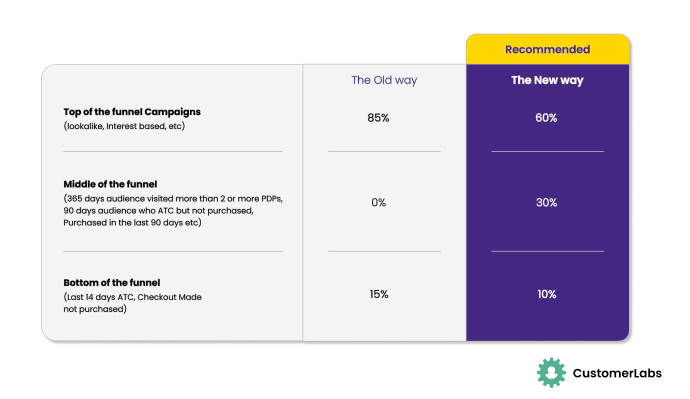
Based on our expertise & experience, we suggest that the total ad budget be split into three as opposed to the traditional two buckets (top & bottom of the funnel audience).
Nurturing those mid-funnel audiences by allocating 25 to 30% of the existing budget will fetch an additional 10% of revenue solely from the audience data collected using CustomerLabs 1PD Ops.

Conclusion: What does the Future of Google Retargeting look like?
Relying on third-party data will not suffice going forward in the cookieless world.
It is high-time that you combine your Google retargeting efforts with first-party data to set sail into the future of cookieless ocean.
When you collect the data directly from your users who are already familiar with your website or app, it is more reliable. Google Ads uses this data to more precisely target your users with highly relevant ads.
The ad algorithm also uses your first-party data to find similar audiences based on the criteria you specify. Thus giving the feasibility of tailoring the ads to users who are even not familiar with your brand.
First-party data holds the power to help the advertisers with better attribution to their retargeting ad campaigns. This first party data-driven approach will enhance your ad campaign optimization efforts, budget allocation, and overall performance.
Google has been encouraging the advertisers to collect their own first-party data to build better relationships with their existing customers.
Strikingly, the shift towards first-party data also addresses data privacy concerns and aligns with evolving privacy regulations. Advertisers can ensure compliance by relying on data collected with user consent, enhancing user trust and mitigating privacy-related risks.
To conclude, Google retargeting strategy using first-party data proves to be beneficial to advertisers, marketers and users. You can target the right audience, enhance personalization, measure your ad campaign performance, increase your attribution and the foremost, be in-compliant with data privacy regulations. It’s a win-win situation for the users and businesses.

